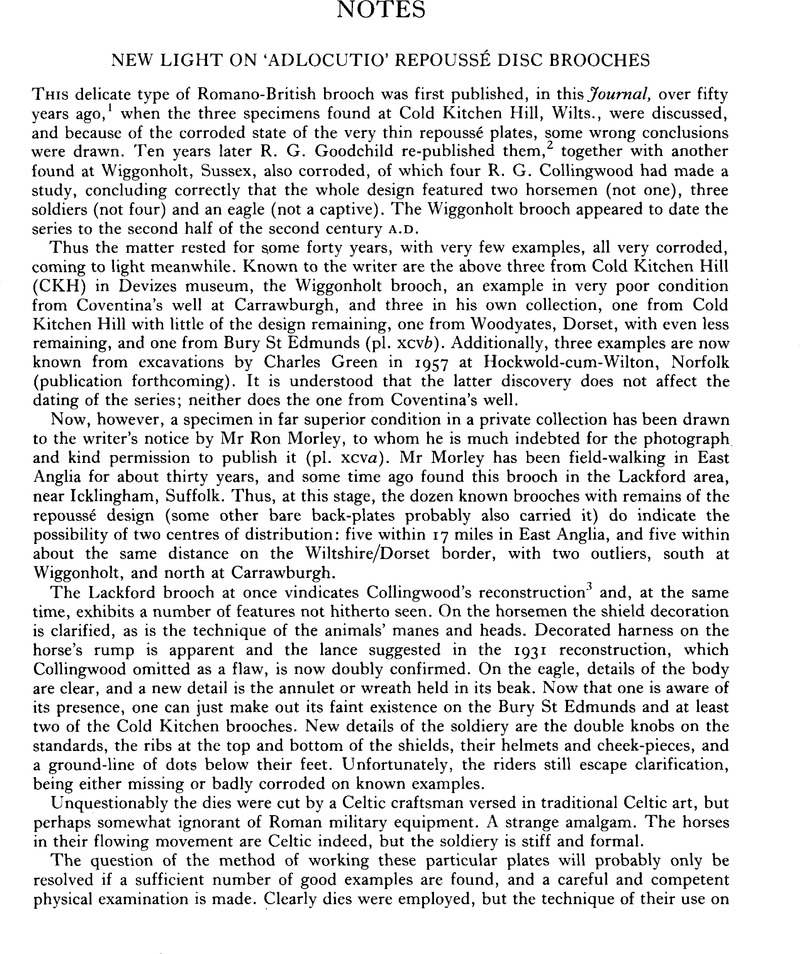No CrossRef data available.
Article contents
New Light on ‘Adlocutio’ Repoussé Disc Brooches
Published online by Cambridge University Press: 21 April 2011
Abstract

- Type
- Notes
- Information
- Copyright
- Copyright © The Society of Antiquaries of London 1985
References
Notes
1 Antiq. J. xi (1931), 160–1.Google Scholar The Adlocutio appellation is retained here as it has become common usage.
2 Ibid., xxi (1941), 1-8.
3 Ibid., fig. 1.
4 Ibid., pl. 11.
5 Ibid., pl. 1.
6 R. I. C. 935/B. M. C. 1687.
7 R. I. C. 690/B. M. C. 1689; R. I. C. 914/B. M. C. pl. 93.4; R. I. C. 923; R. I. C. 924/B. M. C. 1681; R. I. C. 931/B. M. C. 1688; R. I. C. 933/B. M. C. 1686; R. I. C. 935/B. M. C. 1687.
8 R. I. C. 916 and 925.
9 R. I. C. 912/B. M. C. 1692.
10 R. I. C. 690/B. M. C. 1689; R. I. C. 914/B. M. C. pl. 93.4; R. I. C. 931/B. M. C. 1688; R. I. C. 932/B. M. C. 1683.
11 R. I. C. 923.
12 R. I. C. 925.
13 Mack, (The Coinage of Ancient Britain (London, 1963)) 263Google Scholar.
14 Mack 265. There is a very fine example in the National Museum of Wales: Webster, G., Rome against Caratacus (London, 1981), pl. 1 and pp. 14–15Google Scholar.
15 Normally only a small portion of the shield is visible, most of it being hidden by the horse and rider, and the shields vary in shape and the way in which they are held; see the tombstones of Rufus Sita at Gloucester (Toynbee, J. M. C., Art in Roman Britain (London, 1962), no. 87)Google Scholar; Longinus at Colchester (ibid., no. 92); Genialis at Cirencester (ead., Art in Britain under the Romans (Oxford, 1964), pl. XLVIIGoogle Scholar; Flavius at Hexham (ibid., pl. XLVII, b); Bonn, Vonatorix at (Corpus Signorum Imperii Romani, Deutschland, III, I: Germania Inferior, Bonn und Umgebung (Bonn, 1978),Google Scholar Taf. 17 and 18); Marius at Bonn (ibid., Taf. 20); Reburrus at Bonn (ibid., Taf. 21); etc.
16 Mack 146.
17 Mack 376, 378, 386, etc.
18 Mack 390-3, 395, etc.
19 Mack 260.
20 Excellent examples can be seen on the Bonn tombstones referred to in note 15, p. 2, although only a single disc is needed at the junction of the traces.
21 Richmond, I. A., Archaeology and the After-Life in Pagan and Christian Imagery, University of Durham, Riddell Memorial Lecture, 1950Google Scholar.
22 Sydenham, E. A., The Roman Republican Coinage (London, 1952), nos. 398, 341, 446, etcGoogle Scholar.
23 cf. ibid., nos. 545, 483 and 602. Their coins depict men who especially distinguished themselves in combat, T. Manlius Imperiosus Torquatus and M. Servilius Pulex Geminus respectively. There is also a sestertius of Nero which shows the Emperor with an attendant riding to the right and carrying a long horizontal lance, but without a shield (R. I. C. 108 on pl. 19/B. M. C. 155.
24 R. I. C. 922/B. M. C. 1680.
25 R. I. C. 655-8/B. M. C. 1017-19.
26 The first part of this note by R. H., the second (‘The motifs …’) by G. W.




